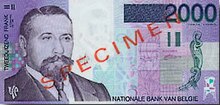Victor Horta
Victor, Baron Horta (6 January 1861 - 8 September 1947) was a Belgian architect and designer. John Julius Norwich said he was "undoubtedly the key European Art Nouveau architect." Horta is one of the most important names in Art Nouveau architecture. Some people say his Hôtel Tassel in Brussels was the first time the style was used on architecture.
Victor Horta | |
|---|---|
 Hota on a Belgian franc banknote | |
| Born | 6 January 1861 |
| Died | 8 September 1947 (aged 86) |
| Nationality | Belgian |
| Occupation | Architect |
| Awards |
|
| Buildings | |
| Projects | Brussels-Central railway station |
In 1932 King Albert I of Belgium gave Horta the title of Baron for his services to architecture. Four of the buildings he designed are UNESCO World Heritage Sites.
Life and career
changeHorta had a great interest in music since childhood. In 1873 he went to study musical theory at the Ghent Conservatory.[1] He was removed for bad behaviour. He then joined the Department of Architecture at the Royal Academy of Fine Arts in Ghent instead.[1] In 1878 Horta left for Paris. He found work with architect and designer Jules Debuysson in Montmartre. There he was inspired by the impressionist and pointillist artists, and also by the possibilities of working in iron and glass.
When Horta's father died in 1880, he returned to Belgium and moved to Brussels. He married his first wife. He studied architecture at the Académie Royale des Beaux-Arts. In Brussels Horta made a friendship with Paul Hankar. He became an assistant for his professor Alphonse Balat, architect to Leopold II of Belgium. Together they designed the royal Greenhouses of Laeken, Horta's first work to use glass and iron.
In 1884 Horta won the first Prix Godecharle to be awarded for Architecture.[1]
By 1885 Horta worked on his own. He was commissioned to design three houses. The same year he also joined the Central Society of Belgian Architecture. Over the next few years he was in a number of competitions for public work. He worked with sculptors (notably his friend Godefroid Devresse) on statuary and even tombs. He won a number of prizes. He thought the forms he made were highly practical and not artistic.
During this period, Horta joined the freemasons.[1] This gave him many clients when he returned to designing houses and shops in 1893.
Horta was appointed Head of Graphic Design for Architecture at the Université Libre de Bruxelles in 1892. He became Professor of Architecture in 1893.[1][2] He worked there until 1911.[2]
Heritage
changeMany of Horta's buildings were destroyed. However, several of Horta’s buildings are still standing in Brussels. Most notable are the Magasins Waucquez, formerly a department store, now the Brussels Comic Book Museum and four of his private houses (hôtels), which are UNESCO World Heritage Sites:
- Hôtel Tassel, designed and built for Prof. Émile Tassel in 1892 - 1893.
- Hôtel Solvay, designed and built 1895 - 1900.
- Hôtel van Eetvelde, designed and built 1895 - 1898.
- Maison and Atelier Horta, designed in 1898, now the Horta Museum, dedicated to his work.
References
change- ↑ 1.0 1.1 1.2 1.3 1.4 Horta: Art Nouveau to Modernism, Harry N Abrams, ISBN 0-8109-6333-7
- ↑ 2.0 2.1 Victor Horta - Biographie Archived 2021-11-25 at the Wayback Machine, Horta Museum, in French or Victor Horta - Biographie[permanent dead link] in Dutch